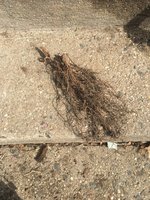Washing off roots not such hot idea. It removes michorrizae from roots best kept present for optimum growth.
I don't believe this is entirely true.
Back in my days at the tissue culture lab we used to try to get field grown plants established in a petri dish-like container. It takes extensive disinfection (10 min 70% ethanol, 8 minutes of bleach solution, 3 rinses with autoclaved water), antibiotics, re-culturing and physically cutting off fresh tissue to get fungi out of plants, especially roots.
And still we had to do things in fifty fold to get one or two "clean" plants that were then placed on culture media containing plant preservative mixture (PPM) to actually beat the microbes back into the plant.
Bacteria? Sure! The ones that don't form a biofilm or colony can sure be washed off with ease. But they multiply quadratically, so that's an issue that's resolved in a couple days.
If myc washes off easily, would cuttings have none of the same myc as their parents? Would root cuttings - where the entire rootball is removed - not have the same issue?
How does myc enter a pot? If it comes from the air, we might be talking about a problem that resolves itself. If the myc is present inside the seed, then it can very well also be present in the seedling itself; it had to get in that seed from some place, which would mean the parent flowers were containing these spores or fungi, which means that the offspring might as well contain them on various other locations.
If the spores are washed off by water, and the myc itself is too, we could save a little of that water and re-inoculate the tree.
Quite interesting when you think about the mechanics of this situation.
I've had cases of large lumps of organic soil being stuck in the rootbase, and I washed those out instead of poking and tearing them out, which I believe provides just as big of an advantage as a fungal colony. A healthy and undamaged bundle of roots outperforms a fungus that needs regrowth in a fresh soil.. At least, that's what I believe.





